Content
- 1 Sowing dates
- 2 Soil preparation
- 3 Sowing seeds
- 4 Dive
- 5 Preparing the soil for transplanting into open ground
- 6 Planting in open ground
- 7 Marigold care
- 8 The benefits of growing marigold seedlings
- 9 What you need to grow marigold seedlings
- 10 How to prepare seeds
- 11 Description of the plant
- 12 Agricultural technology of cultivation
- 13 How to collect and store marigold seeds
- 14 Application in medicine
- 15 Benefits for the garden and vegetable garden
- 16 Types of Tagetes
These vibrant annuals are prized by amateur flower growers and landscaping professionals for their excellent combination of unpretentiousness and excellent decorative qualities. Knowing when to sow marigolds for seedlings, you can admire their flowering from spring to the first frost. Running in time will allow you to shift the flowering period of tagetes (this is the botanical name of this plant).
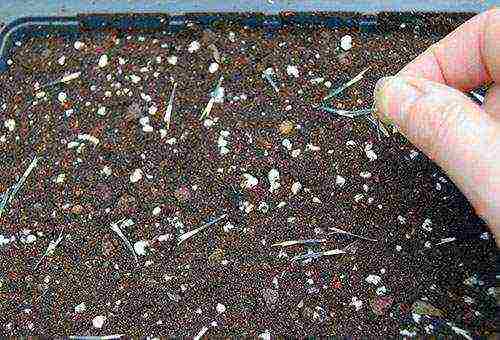
Sowing dates
You can sow marigolds both before winter and in spring. Sowing in central Russia is carried out when the threat of return frosts disappears - from late May to early June. Covering with non-woven material will allow to postpone these terms by another 2 weeks - by the beginning of May. In more southern regions, sowing in the ground can be carried out from the end of March.
Sowing for seedlings depends on the following factors:
- the timing of the establishment of frost-free weather for planting;
- the desired flowering time for marigolds.
Tagetes bloom occurs 1.5-2 months after germination. Therefore, planting marigolds for seedlings falls on the period from March 15 to April 10. Additional illumination of annual crops in the winter months will allow for a short while to bring the flowering time closer. To obtain flowering plants in April-May, seeds are sown at home in January-February.
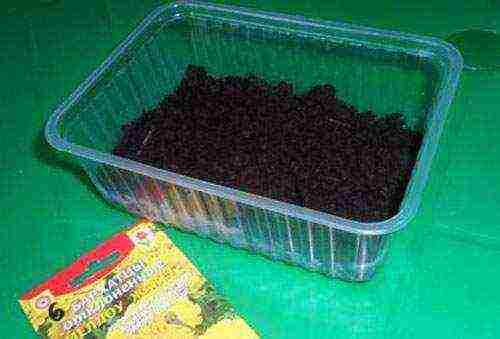
Soil preparation
A fungal disease, colloquially called "black leg", can completely destroy young marigold seedlings. To prevent this from happening, the land for sowing should be carefully prepared. There are several ways to disinfect it.
- A container with an earthen mixture for sowing seeds is spilled with a fungicide solution - Fitosporin, Vitaros, Maxim or any other will do according to the instructions.
- The soil is spilled with a solution of dark pink manganese.
- The earth is steamed in a double boiler or in a water bath for 0.5-1 hours.
- The earthen mixture is treated in a microwave oven for 10 minutes in the "Medium Power" mode.
Advice
Place a drainage layer of expanded clay or crushed stone at the bottom of the seedling box with a layer of at least 2-3 cm.
The composition of the seed mixture may be as follows:
- humus - 1 part;
- garden or vegetable garden land - 2 parts;
- peat - 1 part;
- coarse river sand - 1 part.
There should be holes at the bottom of the container or box for water drainage. Before planting seeds, the soil must be shed in advance and left for a day at a temperature of +18 to + 21⁰С.
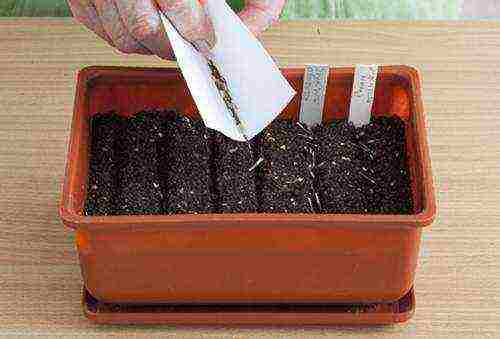
Sowing seeds
On the surface of the prepared substrate, every 3-4 cm, grooves are made with a depth of at least 1 cm, into which the seeds of tagetes are sown at a distance of 1.5 cm from one another.The grooves are sprinkled with a mixture of earth and sifted sand in a 1: 1 ratio. Sowing is carried out not only with dry, but also with swollen and presoaked seeds. They are kept in a damp cloth and plastic bag for 3 days.
Advice
A little sifted furnace ash can be added to the mixture for filling the grooves. This measure will be an additional prevention of the appearance of the "black leg".
If you plan to grow seedlings of several varieties, the crops must be labeled with the name of the variety. At home, it is convenient to use dense foil on which the name of the variety is squeezed out. Such a label will not get wet or fade from sunlight.
The seedling box is placed in a warm place (from +22 to + 25⁰C), covered with a plastic lid, plastic wrap or a layer of plexiglass. Before emergence, this mini-greenhouse must be regularly ventilated. Seedlings at this temperature regime will appear after 4-6 days. The container with seedlings is transferred to a cooler place, reducing the temperature to + 18⁰С.
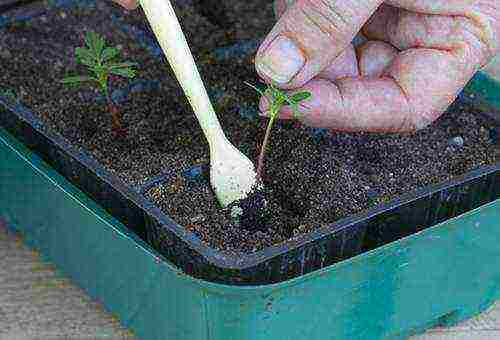
Dive
This operation is carried out when the seedlings have at least 2 true leaves. The soil for placing the cut plants has the same composition as for sowing seeds. Growing an annual will be more successful if you add 1 tbsp to the soil. l. full mineral fertilizer and half a glass of ash for every 5 liters of soil mixture. Plants are placed 7 cm apart from each other. Better yet, do the pick using small peat pots or seedling cassettes.
Advice
When transplanting, you need to pinch off the central root of the seedling by half. If this technique is carried out correctly, then the root system of the tagetes will be fibrous, and the seedlings will be strong and stocky.
The prepared plants are planted in a recess in a pot or cassette up to cotyledon leaves, the roots are straightened and carefully sprinkled with earth. Then the cut seedlings are carefully watered with warm water, trying not to erode the soil from the roots. When it settles, pour in a fresh mixture. If the mineral fertilizer was not applied before the pick, after 10 days the plants must be fed with any fertilizer for seedlings. It is convenient to do this by timing the top dressing for the next watering.
Advice
Tagetes seedlings are grown with infrequent watering. It will be properly watered only after the top layer has dried.
If the seedlings are cultivated in February or early March, they need to be illuminated for 2-3 hours a day, increasing the daylight hours to normal. At home, it is convenient to use fluorescent fluorescent lamps.
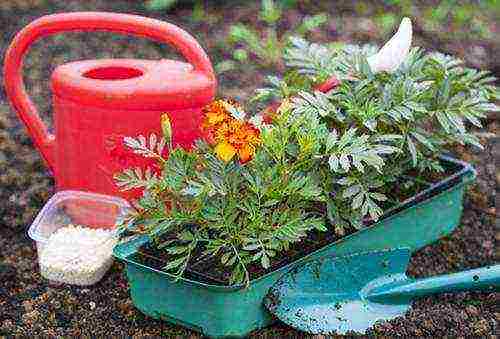
Preparing the soil for transplanting into open ground
The brightest and most beautiful specimens of tagetes can be grown only in a sunny place. It is not necessary to select exclusively fertile soil for transplanting marigolds to a permanent place. For this unpretentious plant, it is enough to follow simple conditions:
- loose, breathable soil;
- permeable earth substrate without stagnant water.
Before planting seedlings in the dug soil, you need to apply full mineral fertilizer (30 g per 1 sq. M.) And close it up.
Advice
The addition of sand and peat contributes to the improvement of heavy clay soil.
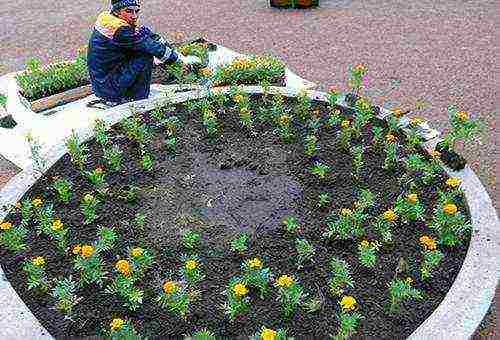
Planting in open ground
To transfer the seedlings to the flower garden, in order to continue growing there, you need to in a certain sequence.
- Prepare wells for seedlings in advance. They need to be done at a distance provided for by the characteristics of the variety, from 15 to 35 cm from each other.
- The root system is placed in a hole, the plant should be planted so that the roots begin 1-2 cm deeper than the surface of the earth.
- The landing hole is sprinkled with earth, the soil is compacted.
- The plant is watered over the leaves or under the root.
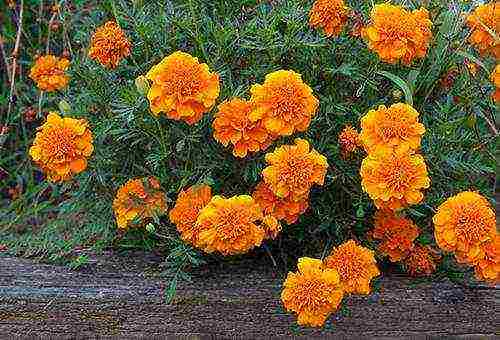
Marigold care
Further cultivation of this annual is not difficult even for inexperienced gardeners. This unpretentious plant withers only during severe drought.Tagetes needs regular watering, weeding from weeds, a single feeding with phosphorus-potassium fertilizer for lush flowering. An excess of nitrogen can lead to the fact that marigolds will build up vegetative mass to the detriment of flowering.
Advice
Mulch the soil around the plants to retain moisture during the dry season.
Marigolds can very rarely be affected by pests, most often aphids. The pest is washed off with a stream of water during irrigation or marigolds are treated with a systemic pesticide for ornamental plants.
Subject to all the intricacies of growing seedlings and systematic care, marigolds will delight you with their flowering and bright greenery throughout the season. This unpretentious plant recovers very quickly after transplanting and diving. With careful selection of sowing dates, not seedlings can significantly extend the flowering season for this annual.
Marigolds, lights, hats, black-haired men - this is how the tagetes are affectionately called. This universal favorite grows quickly and is unpretentious in care. Among its varieties are dwarfs and giants. And even beginners can grow marigold seedlings with their own hands
Useful properties of marigolds
Tagetes inflorescences have various sizes and shapes from small “carnations” to luxurious “chrysanthemums”, and colors from lemon yellow to red-brown. Marigolds are planted in flower beds, in containers, they are conveniently used to cover places that are bare after the flowering of bulbous crops. Tagetes is suitable not only for garden decoration. All parts of the plant contain phytoncides that repel pests and inhibit disease-causing fungi, including those living in the soil. Marigolds are planted on strawberries from a weevil, on cabbage to scare off a whites, next to asters - from fusarium, near phlox and clematis for the prevention of nematodes. Tagetes is used as a medicinal plant and as a spice.
When to sow marigolds for seedlings?
Tagetes propagated by seeds. They can be sown in the ground after the end of the frost, and then thin out or plant the seedlings more freely, but you can plant tagetes with flowering seedlings immediately after the end of the frost.
From germination to flowering of tagetes, it takes from 40 to 50 days, depending on the variety, therefore it is necessary to sow marigolds for seedlings in the first decade of April. The soil for sowing tagetes should be sufficiently fertile and loose. The following land mixture is suitable: peat, humus (or compost), washed sand (2: 1: 0.5).
Sowing tagetes for seedlings Tagetes seedlings often die from the black leg. To prevent this from happening, a container filled with a soil mixture must be spilled in advance with a fungicide solution (Maxim, Vitaros, Fitosporin) or a dark pink solution of potassium permanganate. The best result is obtained by steaming the sifted soil mixture in a double boiler for an hour. In addition to the spores of pathogenic fungi, this will also destroy weed seeds. After lightly compacting the steamed potting mix, make shallow grooves on the surface. The soil should be slightly damp.
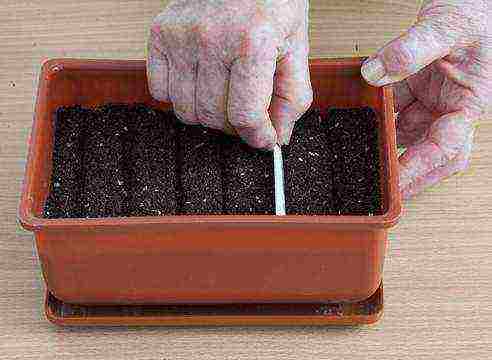
Spread the marigold seeds evenly over the grooves. The most convenient way to do this is with a small piece of white paper. If there are too few seeds, you can spread them out with tweezers. Label the varieties.
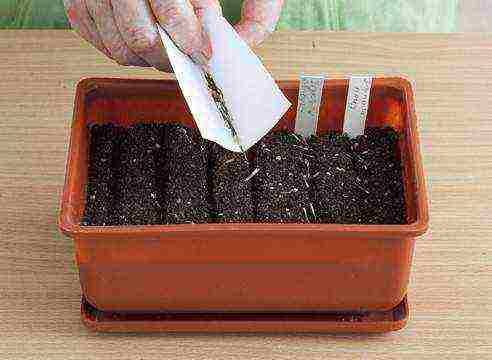
Sprinkle the crops on top with the same soil mixture with a layer of about 1 cm.With smaller sowing, the seed coat remains on the cotyledonous leaves during germination, the marigold seedlings cannot shed the peel, which interferes with their further development.
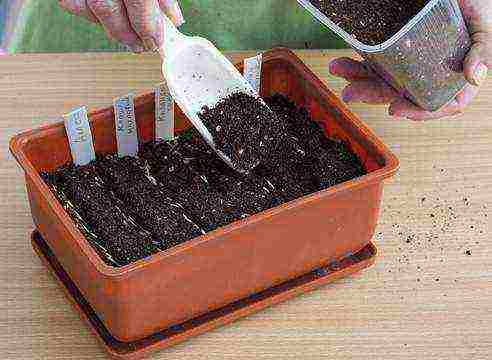
Moisten crops. Try to do this carefully, without eroding the top layer of the soil, so that the seeds do not end up on its surface.
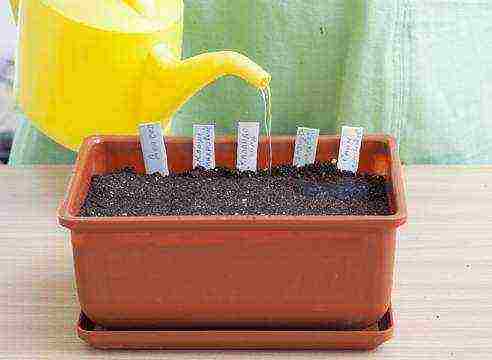
Cover crops to keep the soil moist at all times. For this, it is convenient to use a suitable lid from the food container. You can simply put the container with crops in a clean plastic bag and put it away in a bright place.At a temperature of + 15 ... + 20 ° C, marigold shoots appear in 5-7 days. The temperature regime is important, because at temperatures below + 15 ° С the seeds germinate poorly, and if it rises above + 25 ° С they do not germinate at all.
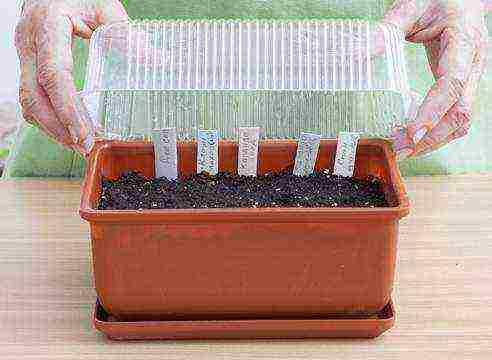
After the appearance of the first shoots, daily ventilation is necessary: at this time, the danger of the appearance of a black leg on the seedlings is highest. If you notice the first signs of the disease, immediately remove the lodging seedlings along with lumps of earth, and sprinkle the holes with fresh soil mixture and re-treat the crops with a fungicide solution.
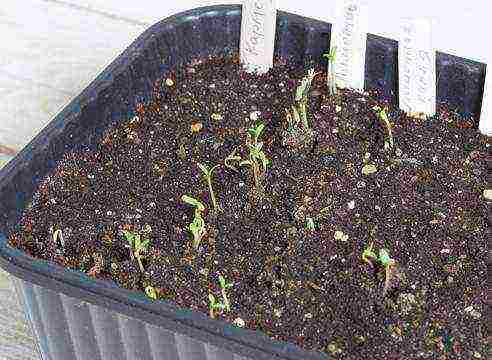
When friendly shoots appear, the shelter must be removed completely. Water after the soil in the container is completely dry, making sure no water accumulates in the pan. Once every two weeks, feed the seedlings with fertilizer for seedlings (Fertika Lux, Agricola, Solution).

After the appearance of 2-3 true leaves, the seedlings are ready for a pick.
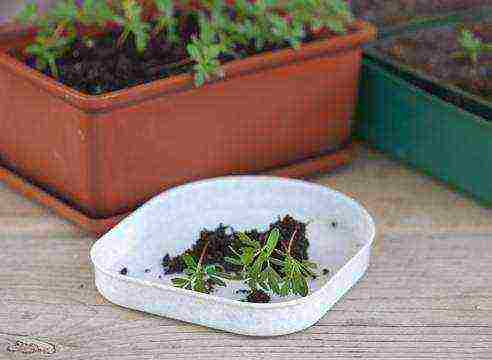
Tagetes picking Tagetes dive at the stage of two true leaves. The seedling can be buried almost to the cotyledons (lower oblong leaves), but so that they do not touch the soil.

You can cut the marigold seedlings simply into the seedling box. Tagetes seedlings tolerate transplanting well even in flowering form - it is not necessary to keep the root ball at the same time. But it is most convenient to grow marigold seedlings in cassettes. The soil can be used with the same composition as for sowing, but without sifting. Add to it 1 tablespoon of a mineral fertilizer containing nitrogen, phosphorus and potassium, and 0.5 cups of wood ash for every 5 liters of the mixture. In order for fertilizers to be evenly distributed in the soil, you need to mix it thoroughly.
Fill the cassettes with the mixture, compact it a little, make depressions so large that the roots fit freely in it. If the roots are too long, they can be shortened a little. When diving, the seedlings need to be deepened by 1 cm.
Water gently. If the soil has settled too much after watering, top up the potting mix. Water regularly after the soil dries. The golden rule for tagetes: it is better not to add a little, than to pour.
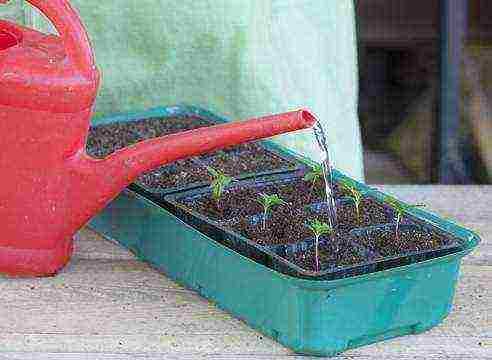
Planting tagetes in the ground Two weeks before planting, gradually begin to accustom the seedlings to fresh air. Marigolds do not tolerate even minor frosts, therefore, seedlings can be planted only when their threat has passed. In the middle lane, this is usually the end of the first decade of June. Choose a sunny place. Although tagetes can grow in partial shade, it will bloom there much worse.
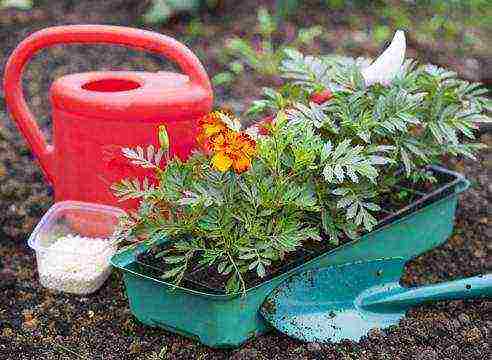
Tagetes does not require fertile soil, the main thing is that it be loose and air- and permeable, without stagnant water. Heavy clay soil will help improve peat and sand.
Dig the soil onto a shovel bayonet, apply a full mineral fertilizer (nitroamofosk, amofosk) at the rate of 30 g per 1 sq. m, embed it in the soil by secondary digging.
Prepare the holes 15-30 cm apart depending on the future size of the plants. Typically, the seed producer indicates on the bags the recommended distance for each variety. Therefore, it is important to keep the seed bags and label the seedlings with the names of the varieties. So you will know exactly at what distance to plant each variety of marigolds. Do the depth of the hole so that when planting, the stems can be deepened by 1-2 centimeters. Place the root system in the hole.

Thoroughly fill in the voids around the roots and compact a little.
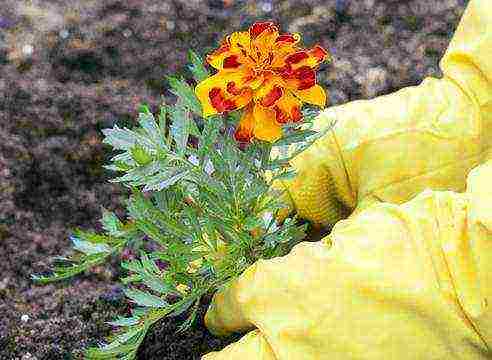
Water the planted seedlings. Tagetes is not afraid of watering over the leaves and rain. Further care consists in weeding and keeping the soil loose. If you have filled the soil with mineral fertilizers, then it is enough to feed Tagetes 1-2 times with phosphorus-potassium fertilizers during the season. These elements contribute to a more lush flowering. With an excess of nitrogen, tagetes grows strongly to the detriment of the formation of new buds.
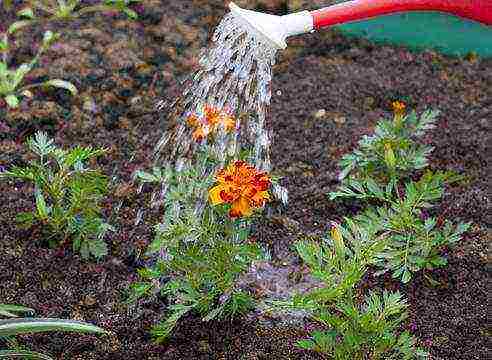
Go to the main article about tagetes
Tagetes (or simply marigolds) are completely unpretentious flowers. These joyful "suns" of warm yellow-orange and reddish-variegated shades are an indispensable attribute of any flower bed. Marigolds grow well in the ground, in balcony boxes. They are easy to decorate with them. They are easy to care for.
When to sow marigolds for seedlings
The benefits of growing marigold seedlings
You can also grow tagetes in a seedless way by sowing seeds directly into the soil in a flower bed. But much earlier (almost a month) they will bloom if you sow seeds for seedlings. And for the landscape design of the site it is so more convenient. In the case of sowing seeds in the ground, the flower beds will not only have to wait with beauty, but it is also unknown how the seeds will sprout. The flowerbed may turn out to be uneven with "bald spots". Therefore, the vast majority of flower growers grow marigolds with seedlings, and they prefer to receive seedlings with their own hands.
Marigold seedlings will bloom in the garden earlier
What you need to grow marigold seedlings
It will not be difficult to grow marigold seedlings in an apartment. You will need:
- Seeds.
- Soil and drainage.
- Boxes or containers.
- Lamps for supplementary lighting.
- Shelter glass or film.
- Complex fertilizers for flower seedlings.
How to prepare seeds
When growing marigold seedlings, it is advisable to take seeds no older than two years (this is the germination period of this crop). You can sow dry seeds - it is more convenient to work with dry seed. But to increase germination, it is preferable to soak the seeds in water at room temperature or even germinate in a humid environment. Also, seeds, especially those collected from their site, must be disinfected in a solution of potassium permanganate. If you don't want to work with wet seeds, you can dust them with fungicide powder by placing them in a bag and adding a pinch of the powder.
Seedling seeds must be no older than two years
When to sow
To calculate the exact timing of hanging Tagetes for seedlings, it is necessary to take into account the following factors.
- The weather in your area. Possibility of return frosts. The timing of the onset of stable heat.
- The timing of receiving flowering plants - in what month do you want to have a blooming flower bed of marigolds.
- From sowing to flowering, marigolds, depending on growth conditions and varieties, will take 1.5-2.5 months.
February - the optimal month for sowing marigolds. If you did not have time to orient yourself or prepare for sowing, it can be carried out in March, but then flowering tagetes will appear on your flower bed only in June.
February is the best month for sowing marigolds
Soil and seedling containers for Tagetes
The Tagetes need a very light land of medium fertility. For sowing seeds, the medium should be neutral, and preferably slightly acidic. Hybrid varieties are more demanding on the composition of the soil.
Seedling boxes or containers are prepared for sowing. Fill them with moistened soil by 3/4. The seeds are laid out in shallow grooves (about a centimeter) in three centimeters increments. Sprinkling crops is carried out with a mixture of peat or leaf earth with sand. From above, the soil is generously sprayed with water from a spray bottle. Be sure to cover the box with glass or plastic. The shelter periodically needs to be removed and the crops aired.
The process of sowing marigolds in the grooves
How to care for marigold seedlings
Tagetes is very thermophilic, does not tolerate even light frosts, therefore, there is one more plus in the propagation of seedlings - a guarantee against freezing of seeds and seedlings during early sowing in open ground.
| Warmly | The temperature of the containers with crops before the emergence of seedlings is not lower than + 22 ° С, and optimally - + 24 ... + 25 ° С. The first shoots, if the seeds have undergone pre-sowing treatment, will appear on the 5-6th day. Dry untreated seeds can germinate up to 10-12 days. Further temperature for good development of seedlings should be reduced to + 18 ... + 20 ° С |
| Light | Marigolds need a lot of sunlight.Therefore, they are planted on flower beds in open places, avoiding shade. Seedlings of Tagetes at all stages, starting from the emergence of seedlings, need additional lighting. Marigolds need to be illuminated 12-13 hours a day. This is done in the daytime - the plants must rest at night. Illumination should be carried out by fluorescent lamps, phyto-lamps, LEDs or any lighting devices intended for supplementary illumination of plants |
| Watering and feeding | Marigolds don't like water. In adulthood, they are surprisingly resistant to drought, but during the growth period from seed to seedlings, they need constant abundant moisture.
You can start feeding the plant 14 days after germination and do it every two weeks. Last feeding - 14 days before disembarkation |
| Picks | When two true leaves appear, the first pick is made. Tagetes do not need individual pots at this stage - they can dive into large boxes, increasing the step to 7 cm.
The next pick can be carried out in a month already in pots with a diameter of 12 cm.This will make it easier to plant plants on a flower bed |
Disembarkation
Planting marigolds in the ground occurs from April to June
Marigolds easily tolerate all procedures associated with their movement. They can not only be dived, but also transplanted in a state of budding and even the appearance of flowers.
Planting seedlings in a flower bed can (depending on the climate) begin at the end of April. Most often, the landing time is selected in May. In especially cold regions - June.
Advice! It is always better to wait with marigold seedlings without planting them until the last moment.
The plants are planted in shallow holes at a distance of at least 15 cm (for low varieties) and a maximum of 40 cm (for high varieties).
Tagetes can be planted not only in flower beds. This plant is a real garden "doctor". Planted along the perimeter of the garden, marigolds will protect garden plants from most diseases and numerous pests. Plants also heal the soil.
Marigolds are planted at a distance of 15 cm from each other
Flower garden care
Caring for flowers in a flower bed is simple. It includes standard floriculture activities:
- watering;
- weeding;
- removal of dried flowers.
To reduce the number of weeds and reduce watering, plantings of tagetes can be mulched.
These lovely, persistent, lush flowers in vibrant optimistic hues are sure to please you. They will create a positive mood and summer flower bed design. Tagetes will look great both in the greenery of the garden and on the vegetable garden or on the lawn. They go well with other colors and have no antagonists. Marigolds are excellent predecessors for all horticultural crops.
Video - How to sow marigold seeds for seedlings
 Marigolds are one of the favorite annuals among gardeners. Lush bushes with carved foliage and bright flowers can be found on almost every site, emitting a spicy aroma familiar from childhood. Velvet flowers bloom almost all summer, delighting with an abundance of inflorescences.
Marigolds are one of the favorite annuals among gardeners. Lush bushes with carved foliage and bright flowers can be found on almost every site, emitting a spicy aroma familiar from childhood. Velvet flowers bloom almost all summer, delighting with an abundance of inflorescences.
Description of the plant
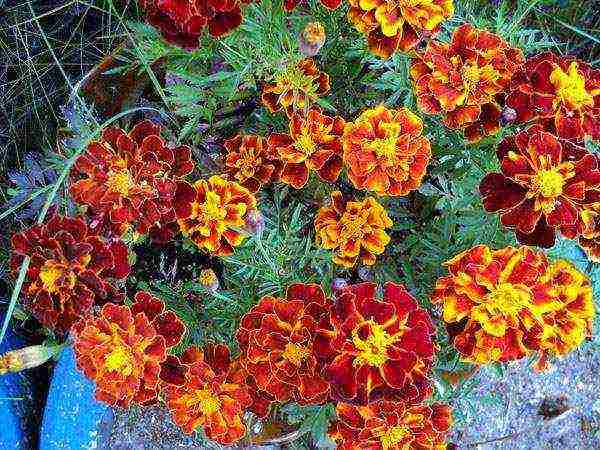 Marigolds, or tagetes, belong to the genus of annuals and perennials in the Aster family. Erect branched stems form a bush with a height of 20 to 120 cm. The leaves are feathery, delicate, the root system is fibrous. Inflorescences are baskets, simple or double, yellow, orange or brown. Abundant flowering from mid-summer to frost. The fruit is achene, 1 g contains up to 700 seeds. The whole plant gives off a spicy aroma. It grows best in sunny places, although it tolerates a little shade. The soil should be nutritious, moderately moist.
Marigolds, or tagetes, belong to the genus of annuals and perennials in the Aster family. Erect branched stems form a bush with a height of 20 to 120 cm. The leaves are feathery, delicate, the root system is fibrous. Inflorescences are baskets, simple or double, yellow, orange or brown. Abundant flowering from mid-summer to frost. The fruit is achene, 1 g contains up to 700 seeds. The whole plant gives off a spicy aroma. It grows best in sunny places, although it tolerates a little shade. The soil should be nutritious, moderately moist.
Marigolds are widely used to create flower groups, flower beds. Low-growing varieties are beautiful both in the curbs and in the massifs, on the lawn. Planted in a pot, they can bloom for a long time in a room. The culture is suitable for growing in balcony boxes, containers.Cut inflorescences stand in water for a long time.
Agricultural technology of cultivation
Tagetes is unpretentious, grows and blooms in almost any conditions, but with good care, the bushes look much more decorative. It is grown in two ways - seedling and sowing seeds in the ground.
A seedless way of growing marigolds
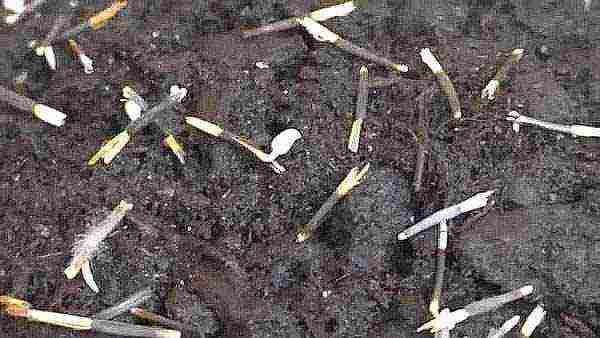 Marigolds are grown by sowing seeds in the ground at different times:
Marigolds are grown by sowing seeds in the ground at different times:
- Before winter, after the onset of a stable minus. Ridges are formed in advance, grooves are made and a little earth is stored in a warm place. The seeds are sown in dry soil and sprinkled with the stored soil. Top mulch with rotted sawdust, compost, leaf litter. In the spring, when the last frosts have passed, the mulch is raked so that the soil warms up faster.
- In the spring, in mid-April - early May, marigolds are sown on insulated ridges or greenhouses. After sowing, the grooves are shed with warm water.
In early - mid-May, tagetes are sown directly into the ground to a permanent place. The emerging seedlings are thinned out, leaving at least 10 cm between the plants. When several true leaves appear on the seedlings, they are planted at a distance of 30–40 cm.
How to grow marigold seedlings in a greenhouse
 Marigolds from seeds are successfully grown in a greenhouse. Landing dates begin when forecasters no longer promise a decrease in night temperatures below –1 –3 ° С. The soil in the greenhouse thaws quickly already in the first warm April days.
Marigolds from seeds are successfully grown in a greenhouse. Landing dates begin when forecasters no longer promise a decrease in night temperatures below –1 –3 ° С. The soil in the greenhouse thaws quickly already in the first warm April days.
To prevent hatching seedlings from being caught by night frost, use a covering material. You can also put containers with water in the greenhouse. During the day it heats up and at night it gradually gives off heat, maintaining the temperature several degrees higher than outside.
Seedlings appear in a week. Caring for marigold seedlings consists in regular watering with warm water, loosening and weeding. If the soil has been prepared in advance, young plants do not need separate feeding. If necessary (weak growth, yellowing of leaves) foliar spraying is carried out with 1–3% urea solution. By mid-May, the seedlings are ready for transplanting into open ground.
How to grow marigold seedlings at home
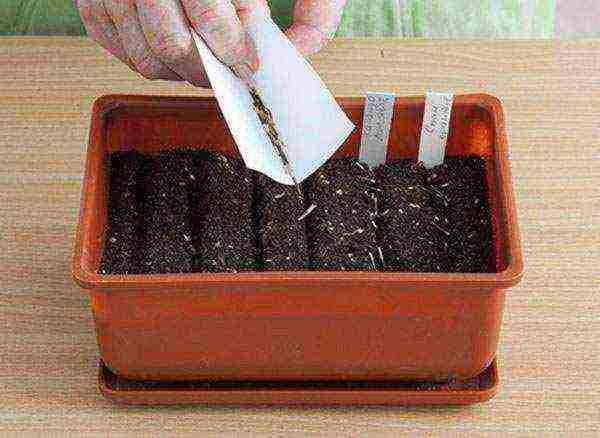
The most reliable way to get flowering plants in the early stages is to plant marigolds on seedlings. Like the main seedlings - peppers and eggplants, they are sown at the end of February - in March. More exact dates depend on the climate and region of residence.
The soil for sowing marigolds is prepared in the following proportions:
- 1 part compost;
- 1 part peat;
- 1 part of garden land;
- 0.5 parts of sand.
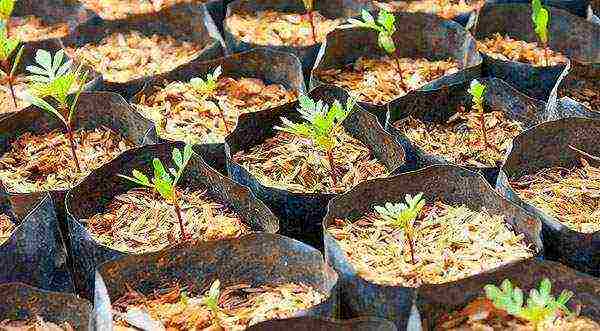 A drainage layer is poured onto the bottom of the tank - broken brick, expanded clay, coarse sand. Then - the prepared soil mixture. It is lightly compacted and watered. A drug against fungal diseases can be added to the water for irrigation, since Tagetes seedlings often suffer from black legs. A few days later, when the earth settles and is evenly saturated with moisture, grooves are made and marigold seeds are laid in them.
A drainage layer is poured onto the bottom of the tank - broken brick, expanded clay, coarse sand. Then - the prepared soil mixture. It is lightly compacted and watered. A drug against fungal diseases can be added to the water for irrigation, since Tagetes seedlings often suffer from black legs. A few days later, when the earth settles and is evenly saturated with moisture, grooves are made and marigold seeds are laid in them.
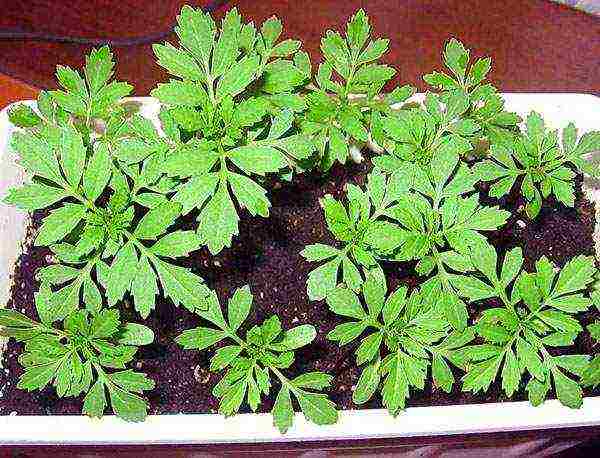 Sprinkle with earth on top and moisten a little more. The pots are covered with glass or foil and placed in a warm, bright place. The cover is regularly removed for ventilation. After the first shoots appear, the film is removed and the containers are moved to a sunny place. Water very sparingly until the seedlings develop their first true leaves to prevent blackleg disease.
Sprinkle with earth on top and moisten a little more. The pots are covered with glass or foil and placed in a warm, bright place. The cover is regularly removed for ventilation. After the first shoots appear, the film is removed and the containers are moved to a sunny place. Water very sparingly until the seedlings develop their first true leaves to prevent blackleg disease.
Caring for seedlings at home is no different from the agrotechnology of growing seedlings in the open field: timely watering, top dressing and good lighting will allow you to get the first marigold flowers in June.
Planting seedlings in open ground
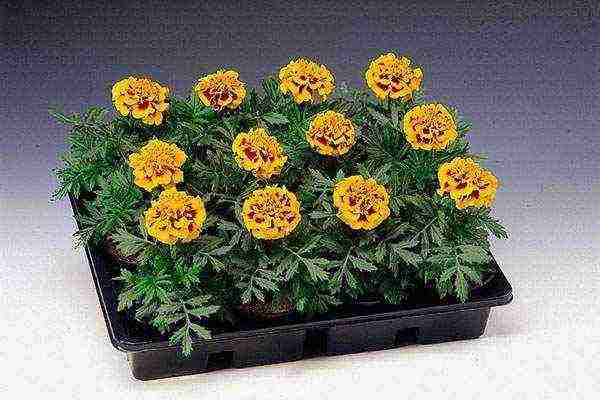 The optimal distance between plants when planting marigold seedlings in open ground is 0.4–0.5 m for upright varieties. Low-growing ones can be planted a little more often. The place should be sunny, without stagnant air.
The optimal distance between plants when planting marigold seedlings in open ground is 0.4–0.5 m for upright varieties. Low-growing ones can be planted a little more often. The place should be sunny, without stagnant air.
Plants are transplanted together with a clod of earth. Before planting, marigolds should be watered so that the roots do not dry out during transplantation.It is advisable to prepare a place for the future flower bed in the fall - to add phosphorus-potassium fertilizers, ash and dig it up. When planting seedlings in the ground, compost, urea or saltpeter are added under each root. But you should not be zealous with nitrogen, so that the plants do not grow fat, that is, they do not increase the green mass to the detriment of flowering. Spraying with a solution of micronutrient fertilizers for flowers will be of great benefit to velvet flowers. This is done after the plants have taken root, started growing and began to pick up buds.
Outdoor Tagetes care
 Marigolds are moisture-loving, but they do not like long stagnation of water. Therefore, watering should be moderate. After watering, the ground must be loosened. For abundant flowering several times per season, the flowers are fed with infusion of mullein or liquid fertilizer from nettle and other weeds.
Marigolds are moisture-loving, but they do not like long stagnation of water. Therefore, watering should be moderate. After watering, the ground must be loosened. For abundant flowering several times per season, the flowers are fed with infusion of mullein or liquid fertilizer from nettle and other weeds.
To maintain a high decorative effect, wilted inflorescences are cut off. It is easy to thin out thickened areas by pruning using cut flowers for bouquets.
Diseases, treatment and prevention
 Due to the content of phytoncides, marigolds are less susceptible to diseases than other crops. However, unsuitable conditions for them can cause gray rot disease and an invasion of spider mites. Specimens that are sick with rot are destroyed, in healthy ones, watering is reduced, and they are sprayed with anti-fungal drugs.
Due to the content of phytoncides, marigolds are less susceptible to diseases than other crops. However, unsuitable conditions for them can cause gray rot disease and an invasion of spider mites. Specimens that are sick with rot are destroyed, in healthy ones, watering is reduced, and they are sprayed with anti-fungal drugs. 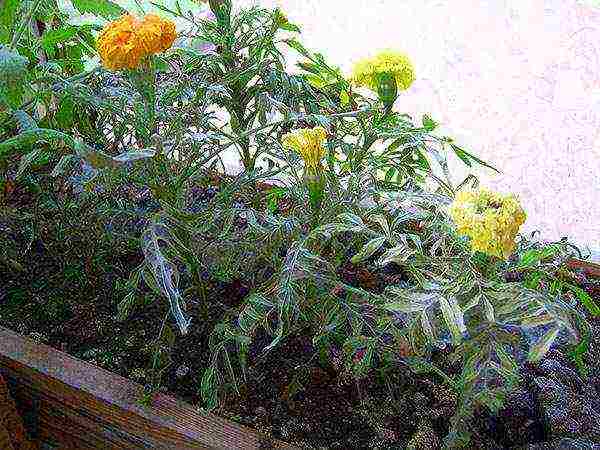 From spider mites, tagetes are treated with infusion of garlic, wormwood, red pepper or tobacco dust. In case of severe damage, the plants are sprayed with solutions of the preparations "Actellik", "Fufanon", "Antiklesh", "Fitoverm".
From spider mites, tagetes are treated with infusion of garlic, wormwood, red pepper or tobacco dust. In case of severe damage, the plants are sprayed with solutions of the preparations "Actellik", "Fufanon", "Antiklesh", "Fitoverm".
Plant marigolds in sunny, blown places that do not thicken, and the plants will bloom more abundantly and less pain.
How to collect and store marigold seeds
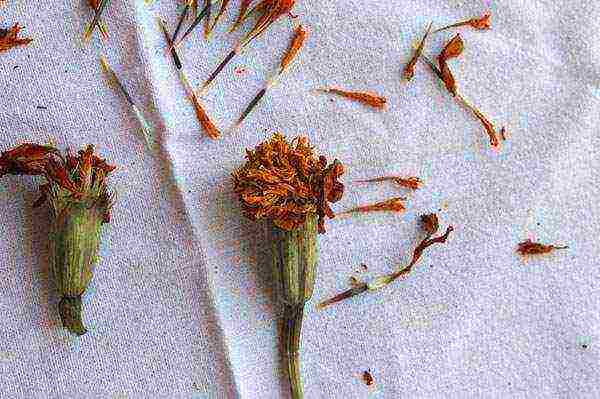 With good care in the open field, marigolds planted in May-June, by mid-August, form faded and dried achenes filled with seeds. They are quite large and resemble an arrow with a black tip and light plumage. The largest specimens are collected for seeds. The collected achenes are dried in a dry place and cleaned, freeing from the husk.
With good care in the open field, marigolds planted in May-June, by mid-August, form faded and dried achenes filled with seeds. They are quite large and resemble an arrow with a black tip and light plumage. The largest specimens are collected for seeds. The collected achenes are dried in a dry place and cleaned, freeing from the husk.
Seeds are harvested only from varietal marigolds, hybrids are not suitable for this, since they inherit the traits of only one of the parents.
Well-dried seeds are poured into fabric bags and stored at a temperature of 1–5 ° C and a humidity of 50–60%. In such conditions, the planting material does not lose its germination for several years.
Application in medicine
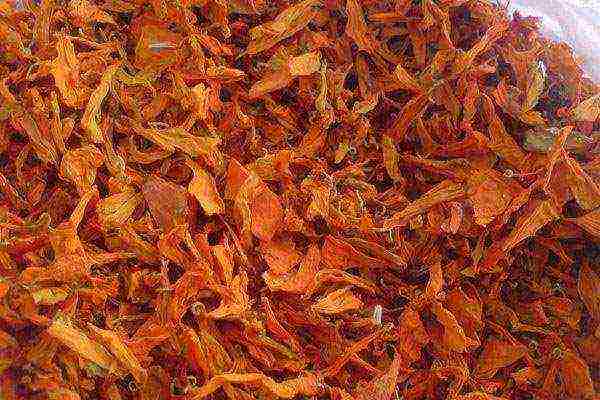 A bouquet of cut marigolds heals the air in the room, scares away flies. Dried petals are used as a condiment in some countries. In the Caucasus, it is known as Imeretian saffron. Leaves treat constipation, fever, used as a diuretic and diaphoretic. In large doses, marigold leaves act as an emetic. The lutein contained in flowers reduces the likelihood of developing cataracts and improves visual acuity. Baths with Tagetes infusion relax, relieve anxiety. They are recommended to be taken before bedtime for depression and neurosis. Tincture of the plant copes well with stomatitis and skin diseases.
A bouquet of cut marigolds heals the air in the room, scares away flies. Dried petals are used as a condiment in some countries. In the Caucasus, it is known as Imeretian saffron. Leaves treat constipation, fever, used as a diuretic and diaphoretic. In large doses, marigold leaves act as an emetic. The lutein contained in flowers reduces the likelihood of developing cataracts and improves visual acuity. Baths with Tagetes infusion relax, relieve anxiety. They are recommended to be taken before bedtime for depression and neurosis. Tincture of the plant copes well with stomatitis and skin diseases.
On an industrial scale, marigolds are grown to obtain essential oils.
The raw material for it is the entire aboveground part of plants. The oil has a sweet fruity aroma with a light citrus note. It has a sedative, antifungal, hypotensive, antiseptic effect. It softens the skin well, at the same time scaring away flying flies and mosquitoes. Helps heal cuts, scrapes, softens calluses.
Marigold oil is a popular ingredient in many French perfumes.
Benefits for the garden and vegetable garden
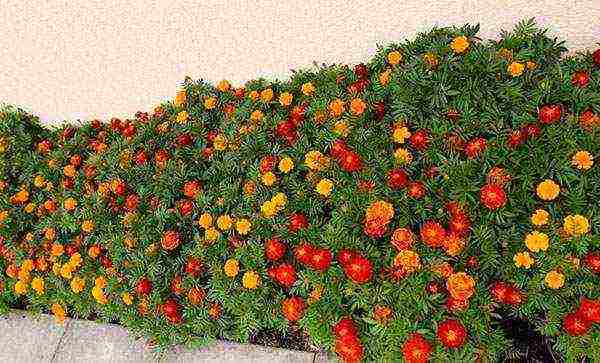 In order for marigolds to fully show their phytoncidal properties, they are planted along the perimeter of the site, along the paths, and the beginning and end of the beds are designated by separate bushes. Tagetes, planted next to cabbage beds, scares off the cruciferous flea.One or two flowering bushes in a greenhouse can significantly reduce the likelihood of tomato disease with late blight and various rot. In autumn, the whole plant is used as green manure - they grind and dig up the ground together with the resulting green mass. This will scare away the nematode, wireworm and enrich the soil with organic matter.
In order for marigolds to fully show their phytoncidal properties, they are planted along the perimeter of the site, along the paths, and the beginning and end of the beds are designated by separate bushes. Tagetes, planted next to cabbage beds, scares off the cruciferous flea.One or two flowering bushes in a greenhouse can significantly reduce the likelihood of tomato disease with late blight and various rot. In autumn, the whole plant is used as green manure - they grind and dig up the ground together with the resulting green mass. This will scare away the nematode, wireworm and enrich the soil with organic matter.
Marigold bushes can be left for the whole winter. Planted in rows, they will serve as wind protection and hold snow on the site.
In the spring, after the snow melts, the dried bushes are pulled out and burned, or sent to compost.
Types of Tagetes
 In summer cottages, marigolds of different heights grow, differing in flowering time, size and color of flowers. Seeds of your favorite variety and type can be bought in almost any specialty store.
In summer cottages, marigolds of different heights grow, differing in flowering time, size and color of flowers. Seeds of your favorite variety and type can be bought in almost any specialty store.
Erect marigolds (Tagetes erecta)
In terms of shape, the inflorescences are divided into two groups:
- clove-flowered - this group has many reed flowers in inflorescences, few tubular flowers in the center;
- chrysanthemum-flowered - the entire inflorescence consists of tubular flowers, along the edge of one row of reed flowers.
Erect varieties of Tagetes are among the highest. Among them are many beautiful, with large globular inflorescences of yellow and orange flowers.
Antigua - low bushes are strewn with many yellow-orange flowers up to 10 cm in diameter.
Yellow stone - a plant up to 70 cm high looks like a chrysanthemum with large light yellow spherical flowers.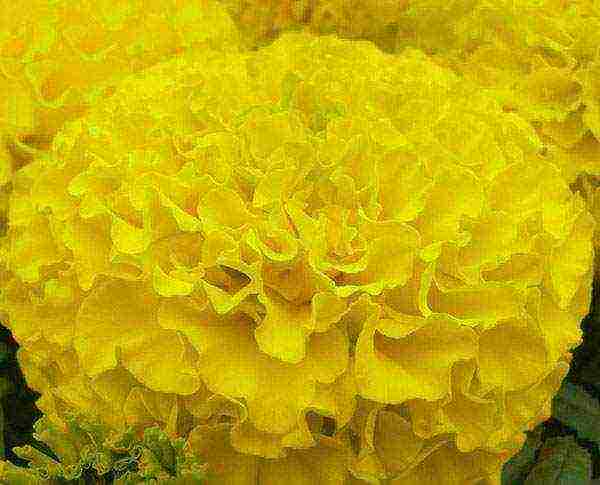
Gold dollar - tall bushes with large dark green leaves beautifully set off red-orange odorless terry balls.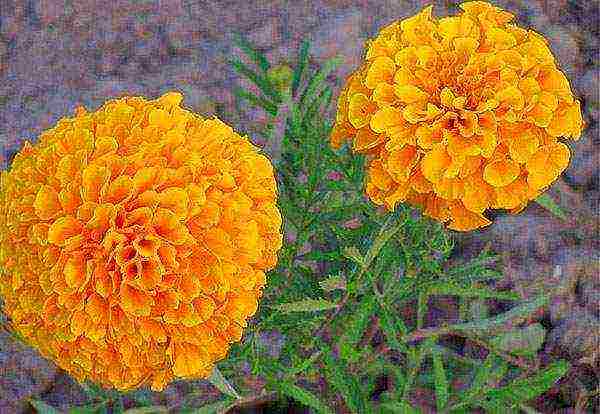
Golden light - compact plants of medium height topped with bright orange lights. Late variety, blooms from late June until frost.
Lemon Prince - from the beginning of summer to cold weather, it will delight you with a combination of lemon-yellow inflorescences with dark emerald carved foliage. The variety is 80 cm high.
Shaggy Robin - the pale yellow heads do look shaggy due to the tubular flowers of different lengths. They look beautiful and unusual when cut.
Rejected marigolds (Tagetes patula)
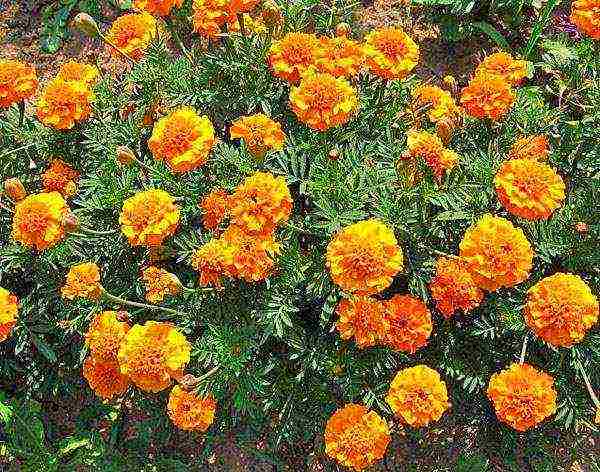 This species is of average height - 20–40 cm. Flowers may not be double, but no less beautiful, often two-colored.
This species is of average height - 20–40 cm. Flowers may not be double, but no less beautiful, often two-colored.
Gold head - low, strongly leafy bushes covered with many yellow inflorescences with red edges. The outer petals are wavy and bent down. The variety is recommended for growing in containers, pots, flower beds and flower beds.
Golden ball - Sprawling branchy bushes will delight you with an exquisite combination of golden middle in red-brown edging. Blooms from early summer. The variety is good for cutting.
Queen Sofia - red-brown shades of terracotta, cinnamon and bronze fade slightly in the sun, acquiring almost chocolate tones. Inflorescences are non-double, but large.
Lemon Jewel - the name of the variety speaks for itself. Compact strongly leafy bushes firmly hold a scattering of terry bright yellow flowers.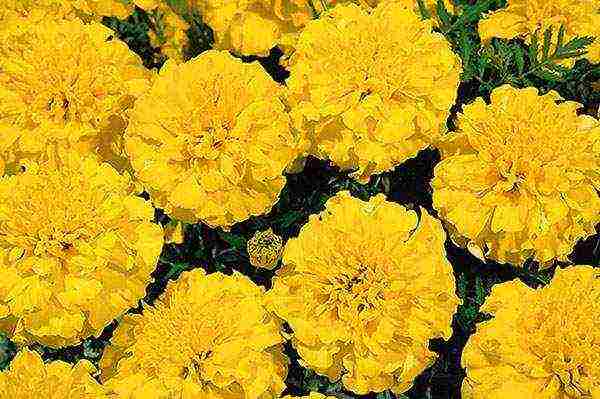
Orange flame - the variety will not leave anyone indifferent due to the two-color spherical inflorescences with a bright orange center in a red-brown design.
Fine-leaved marigolds (Tagetes tenuifolia),
 Thin-leaved varieties have thin, strongly cut foliage and small non-double flowers of yellow, orange or red flowers. Flowering bushes resemble fishnet balls, dotted with many bright lights.
Thin-leaved varieties have thin, strongly cut foliage and small non-double flowers of yellow, orange or red flowers. Flowering bushes resemble fishnet balls, dotted with many bright lights.
Golden ring - a plant of medium height with fragile shoots and small light green leaves. It blooms from the beginning of June with bright yellow small flowers with dark orange edging.
Dwarf - similar to the previous variety, but differs from it in its small height. Therefore, it is recommended for decorating the edges of flower beds, rabatok. Beautiful and convenient for growing in pots and boxes.
Lulu - the variety is distinguished by abundant flowering. The spreading bush forms a green ball, strewn with bright yellow stars.
Paprika - a lot of fiery red flowers with a yellow center will not go unnoticed in any flower bed. The variety repels pests with a strong aroma.
With such a variety of varieties, you can make an elegant and long-flowering flower bed only from marigolds alone, alternating different colors. Tall large-flowered varieties are placed in the center of the flower bed, framing them with low-growing varieties of a contrasting shade. Velvets planted in balcony boxes will fill the apartment with a delicate spicy aroma all summer long.
The most important thing about marigolds - video


